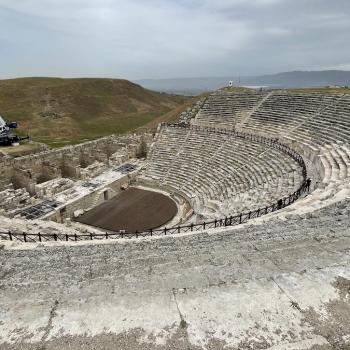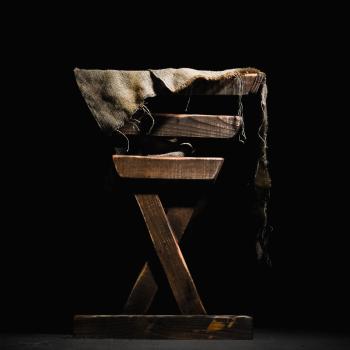
You might think that there is as much myth surrounding St. Nicholas as the jolly old fellow we know today as Santa Claus. However, he actually was a real person. He was born sometime during the third century in the village of Patara on the southern coast of modern-day Turkey. The Apostles Paul and Barnabas first brought the gospel to the area around 47AD when they visited the cities of Lycaonia (Acts 14:6-7). In fact, Paul actually visits the city of Nicholas’s birth in Acts 21:1 on his way to Jerusalem.
The Legend
While there is some physical evidence – bones, icons, hagiography – that testify to Nicholas’s life, there are many legends that emerged later in history. He becomes known as the patron saint of sailors and children. Due to family wealth, early traditions arose alluding to Nicholas’s generosity. He is said to have thrown bags of gold into the windows of children and was responsible for raising three children from the dead as well as saving sailors from drowning. We’ll discuss these in a moment.
His feast day corresponds to the most dangerous times to travel across the sea by ship, 6 December. Some suggest that Nicholas simply displaced Poseidon, the Greek god of the sea, as Christianity became the predominate religious expression in the fourth century and beyond.
His Name
His name raises many questions as well. Nicholas is derived from the Greek words nike and laos meaning “victory of the people.” It was not a popular name for Christians largely due to its connection to the Nicolaitans the Apostle John writes about in Rev 2:6, 15. In the second century, Saint Irenaeus thought the Nicolaitans were a cult begun by Nicolaus, one of the seven chosen men in Acts 6:5. According to Irenaeus, the Nicolaitans exploited women as Nicolaus allegedly allowed extra-martial affairs with his own wife as a symbol of his complete abstinence from conjugal relations.
Such legends produce little assurance that Nicholas actually lived in the fourth century. As best we know, he never wrote a theological treaty or compiled a compendium of sermons. Nevertheless, the long tradition of his presence at the council of Nicaea in 325AD suggests he indeed existed. In fact, recent scholarship clearly indicates Nicholas’s presence at the first ecumenical council as evidenced by his name appearing on six lists of those in attendance. Most significantly, his name appears on Theodore the Lector’s list (515AD) as Nicholas of Mrya, the 115th name bishop in attendance (English 2018:311).
The oldest image of our legendary bishop dates from the mid 600s to 700s. Located today at St. Catherine’s monastery in Egypt, the icon illustrates St. Nicholas along with Saints Paul, Peter, and John Chrysostom (English 2018:152). Chrysostom and Nicholas were contemporaries although he was younger and likely more eloquent in speech as his name, “golden mouth,” suggested.
Life of Nicholas
Around the same time period as the icon, a monk, and leader of a large monastery, Michael the Archimandrite took on the task of writing a biography of St. Nicholas entitled Life, Works, and Miracles of our Holy Father Nicholas, Archbishop of Myra in Lycia. Drawing from two prior biographies no longer extant, Michael describes the bishop as illuminating “the way ahead of us like a light-filled beam of the sun of justice, casting the radiance of his virtues like gold-gleaming rays” and stirring “lovers of the poor, and indeed those who love Christ and those who pardon humanity” (Life 1).
Nicholas became well-known for his charity. After his parents died, Nicholas inherited substantial wealth and used that for the good of the poor. Michael wrote, “Nicholas did not cease to continually hand over his abundance — to store it up in the secure treasure-houses of heaven” (Life 9). He wrote of a father Nicholas helped rescue from poverty and forcing his daughters into prostitution by providing three bags of gold thrown through a window on three different nights (Life 10-18). Nicholas defended the true doctrine of Christ against the heresies of Sabellius and Arius (Life 25-26), and led the charge against idols and Pagan temples such as of Artemis so prominent in his city (Life 28-30). Nicholas could rightly be described as a bishop of justice as he stood in the gap to defend three men wrongly accused and sentenced to death (Life 31-32).
Challenges
There are always challenges when trying to wade through the stories of the saints. These hagiographies, as they are called, combine a grain of truth with incredible feats of healing or deliverance. Nicholas’s story was not immune to this. Michael recounts,
When the fame of his holiness and care had been spread abroad to almost all the world and was being borne about on everyone’s tongue because of these virtuous acts and good deeds and those like them, as is reasonable, some sailors, who were once sailing across the sea, when a mighty swell and storm suddenly arose against them by the plotting of a very fierce wind, saw that they were going to be altogether and completely subjected to a most inevitable danger of death. (Life 34)
No doubt his fame had spread as being a defender of the defenseless and a provider of the poor. He certainly rescued those in need, even in the time of famine,
When the saint received the grain and measured it, he distributed it to everyone as they praised God, who has power over all things, and it came about that the grain sufficed for those who received it from him for a period of two years, as a blessing. (Life 39)
Lover of Christ
Nicholas was a remarkable person who loved Christ more than the world and gave everything for His sake. So, were these myths, legends created to inspire the faithful? Some perhaps. Others seem too fanciful to believe. Yet, juxtaposed to Santa who travels 111 million miles in one evening at an estimated 3.6 million miles per hour on a sleigh with eight tiny flying reindeer – nine if you add Rudolph – then Nicholas’s story seems far more plausible.
Adapted from Unwrapping the First Christmas.












